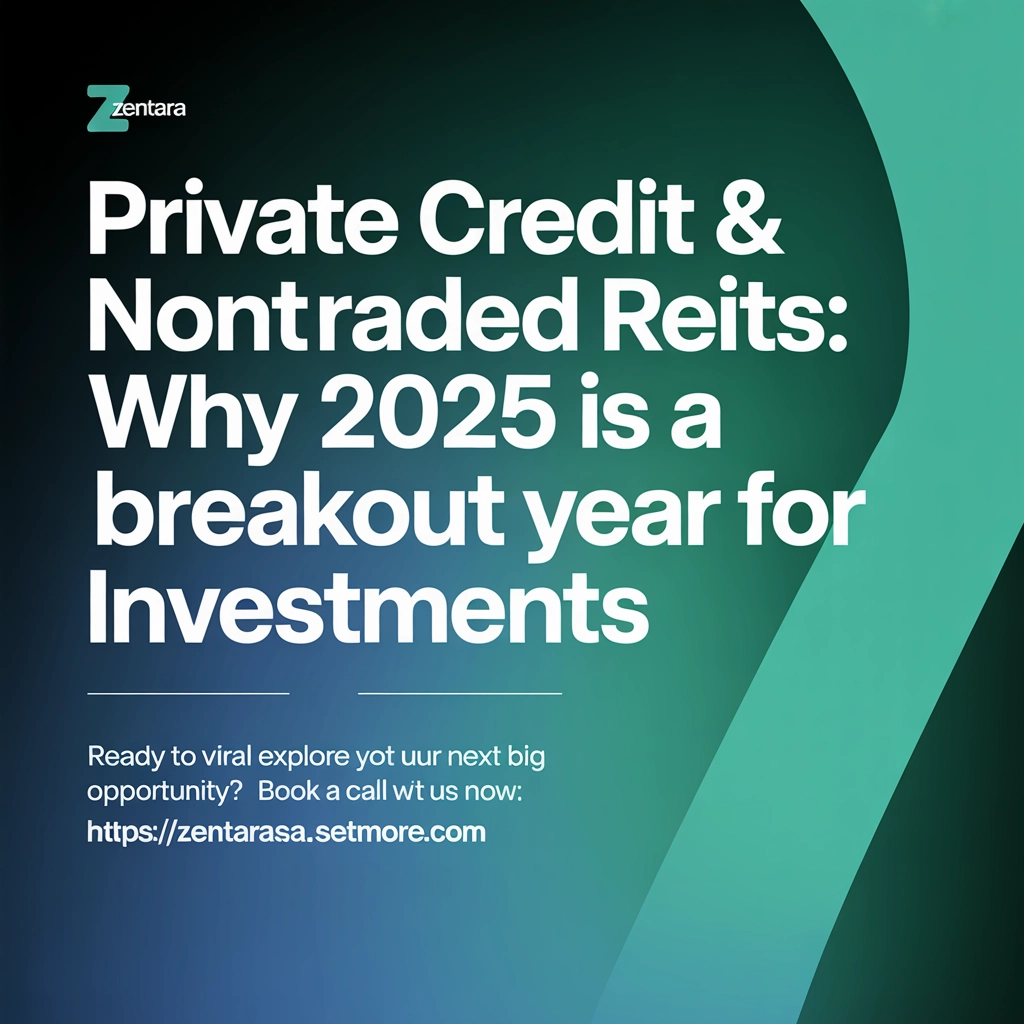Private Credit & Nontraded REITs: Why 2025 Is a Breakout Year for Alternative Investments

Add a viral call to action at the end: Ready to explore your next big opportunity? Book a call with us now: https://zentara.setmore.com
The alternative investment sector is shaking things up in 2025, with private credit and nontraded REITs stepping confidently into the limelight. Shifts in economic conditions, regulatory frameworks, and investor sentiment are fueling a breakout year for these asset classes, transforming both institutional and individual approaches to portfolio construction. Here’s why 2025 stands out—and how savvy investors are capturing the momentum.
Why 2025? The New Investment Landscape
The world looks very different for investors this year. Traditional assets like stocks and bonds have taken investors on a wild ride amid market volatility, inflation, and ongoing geopolitical tensions. At the same time, banks are tightening their lending criteria, leaving a funding gap for companies—especially in the middle market. This convergence is driving capital into private credit and nontraded REITs, which are now considered essential portfolio components rather than niche holdings.
The Private Credit Revolution
Private credit isn’t merely having a moment—it’s experiencing a full-blown revolution. As of 2024, the private credit market boasted nearly $2 trillion in assets under management (AUM) and is projected to hit an eye-watering $3.5 trillion by 2028.
What’s Behind the Surge?
- Bank Withdrawal: After the 2023 regional banking shakeup, banks pulled back from lending, especially to companies below investment grade. Private credit managers raced in, bridging the financing gap with flexible, customized loans.
- Appeal of Higher Yields: With interest rates holding firm, spreads in private credit are offering juicy yields—consistently outpacing standard fixed-income strategies.
- Market Volatility Hedge: Private credit returns show less correlation to public equity and bond markets. For investors fed up with daily volatility, the often-contractual nature of these returns is appealing.

More Than Direct Lending
Private credit now spans beyond classic corporate loans. Asset-backed finance, mezzanine lending, and bespoke deal structures are all on the table. Specialized strategies are emerging in sectors like healthcare, tech, infrastructure, and real estate, where private credit can deliver growth capital and tailored solutions that banks won’t touch.
Institutionals Go Big
This year, the narrative shifted from “niche allocation” to “core strategy.” Insurance companies, pension funds, and sovereign wealth funds are leading the charge. Their reasons? Income stability, diversification, and a way to avoid the rollercoaster of public markets. Even banks (ironic, right?) and a growing number of family offices are stepping up their commitments to private credit vehicles.
Nontraded REITs: Real Assets, Real Returns
While private credit takes the spotlight, nontraded REITs are quietly powering a parallel revolution in real estate investing. In a high-rate, high-volatility world, these vehicles let investors tap into institutional-grade real estate—without the drama of the public markets.
What Makes Nontraded REITs Stand Out?
- Long-Term Income: By focusing on high-quality, income-generating properties, nontraded REITs aim for consistent returns, even when public REITs or stocks gyrate.
- Lower Correlation: These investment vehicles aren’t swayed daily by headlines, providing smoother performance and acting as a stabilizer within diversified portfolios.
- Transparency & Regulatory Progress: The new breed of nontraded REITs is built on better transparency, regular reporting, and investor protections inspired by evolving regulations around the globe.

Thematic & Sector Plays
The most successful nontraded REITs in 2025 are zeroing in on thematic growth: data centers, logistics hubs, healthcare and life sciences assets. These specialized plays not only cushion portfolios against inflation but tap into secular trends turbo-charging real asset values.
Market Drivers Fueling This Breakout
Macro Factors
- High Rates Favor Credit: Central banks holding rates higher for longer makes private credit structures even more competitive on a risk-return basis.
- Volatility Infects Traditional Markets: Choppy equities and bond uncertainty are driving sophisticated investors toward assets with contract-based, predictable income streams.
Regulatory Backdrop
In the US and Europe, private credit and nontraded REITs are coming under closer regulatory scrutiny. While this might sound intimidating, for disciplined managers and investors it’s great news—a more robust, transparent, and professionalized ecosystem means fewer surprises and more accountability.
Changing Borrower Dynamics
Middle market companies are prioritizing certainty and speed of execution over loan cost. They’re willing to pay a premium for direct capital from private lenders and nonbank sources, especially as the IPO and M&A pipeline slows. This dynamic is giving alternative managers more negotiating power and better investment terms.

Sector-Specific Opportunities
- Healthcare: Demand for expansion capital is fueling growth lending, and senior secured loans to asset-rich healthcare operators offer defensive yield.
- Tech: Software and data companies, many post-venture but pre-public, turn to private credit for flexible structures that support growth without equity dilution.
- Infrastructure: Nontraded REITs and private credit fuel projects in transportation, green energy, and digital infrastructure, where public capital is often scarce or slow.
The Maturing Market and What’s Next
This year’s breakout hasn’t gone unnoticed by regulators or risk managers. As alternative investments mature, manager selection and due diligence are more critical than ever. Not every lender or nontraded REIT operator is created equal—investors need to scrutinize track records, fee structures, and risk controls.
Risks to Watch
- Credit Quality: As fundraising booms, there’s always a risk some managers stretch their standards. Watch for underwriting discipline and robust deal sourcing processes.
- Liquidity: Both private credit and nontraded REITs can lock up capital for years. Make sure allocations fit your portfolio’s liquidity needs.
- Market Cycles: While alternatives can offer resilience, they’re not immune to economic downturns. Well-run funds, however, can exploit dislocations for even better deals.

Why Smart Investors Are Allocating More
At Mansa Investments, we’re seeing a clear trend: Private credit and nontraded REITs are moving from the “alternative” shelf to the core of sophisticated investors’ portfolios. The reasons are simple—compelling risk-adjusted returns, stability in a noisy market, and a structural shift toward new sources of yield for the modern era.
Ready to explore your next big opportunity? Book a call with us now: https://zentara.setmore.com






